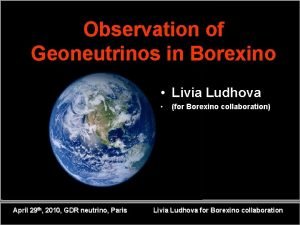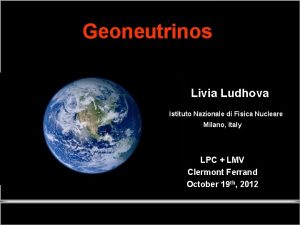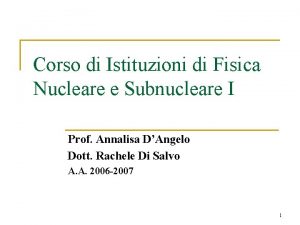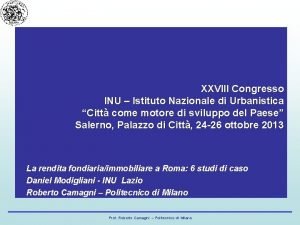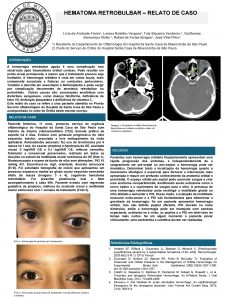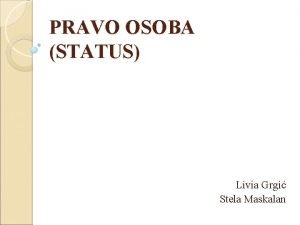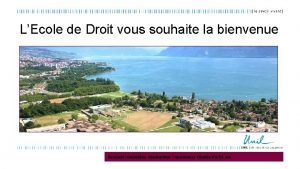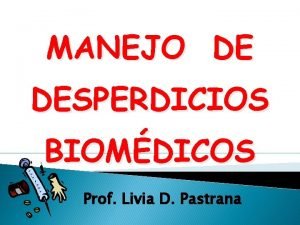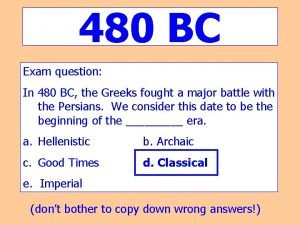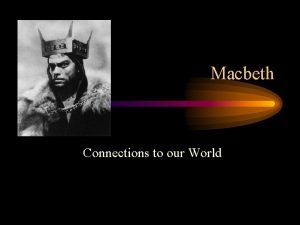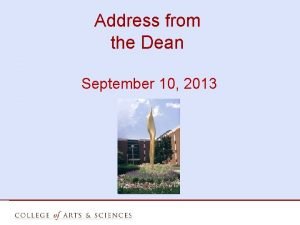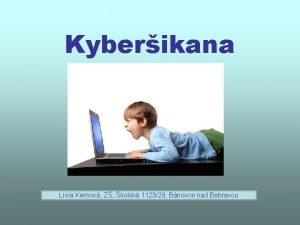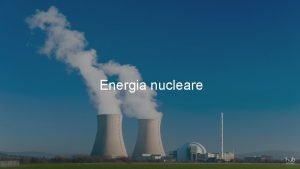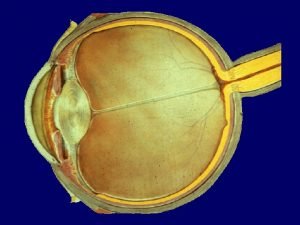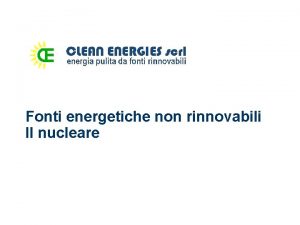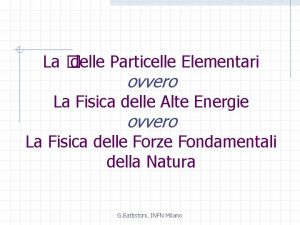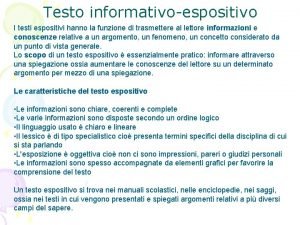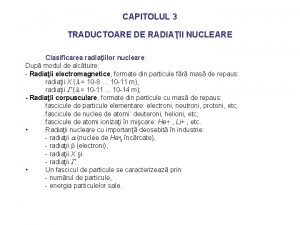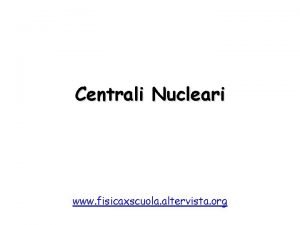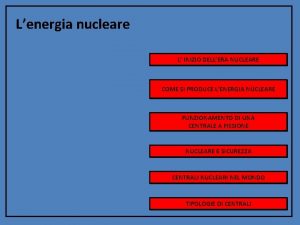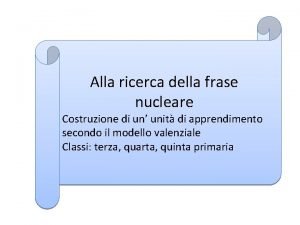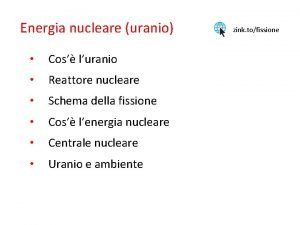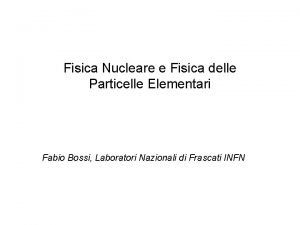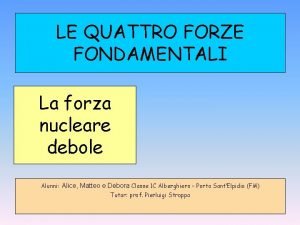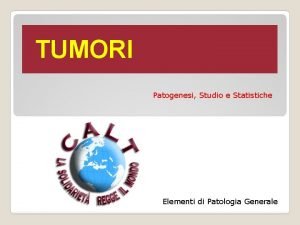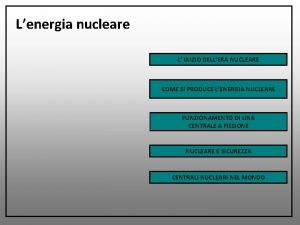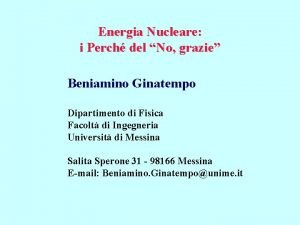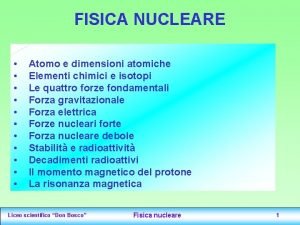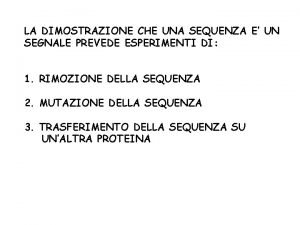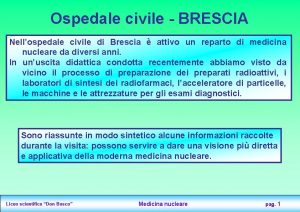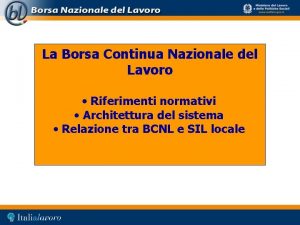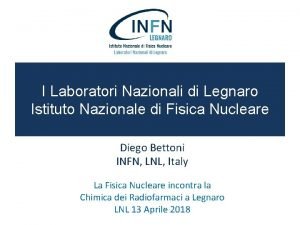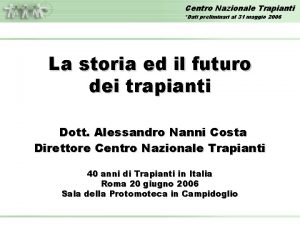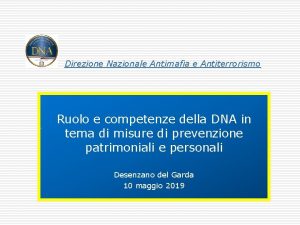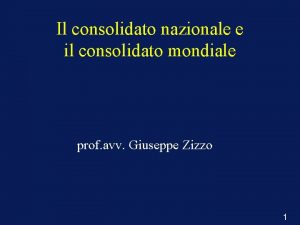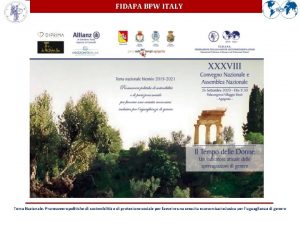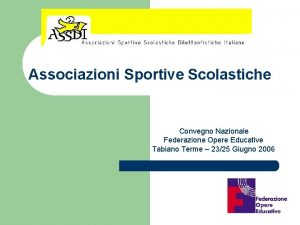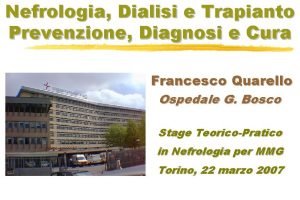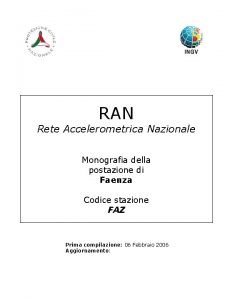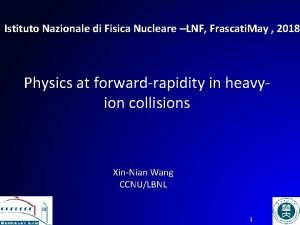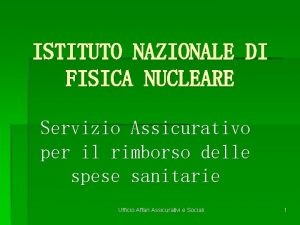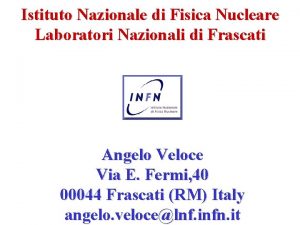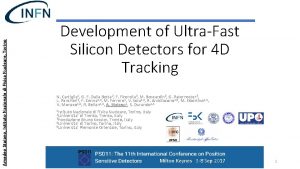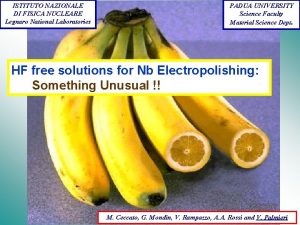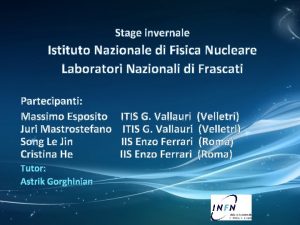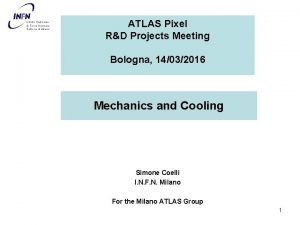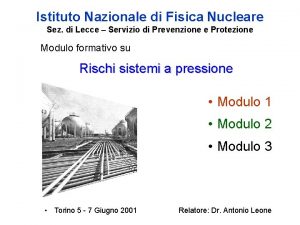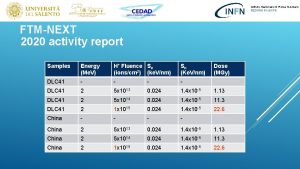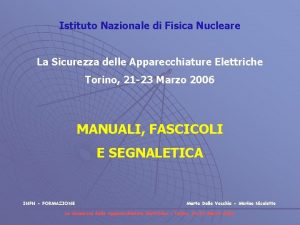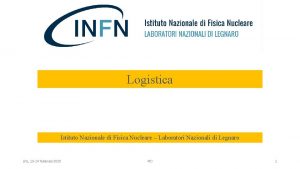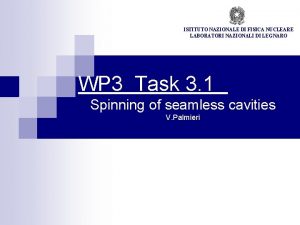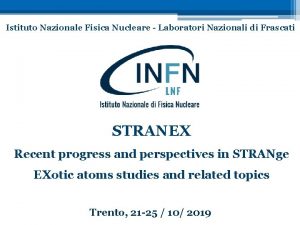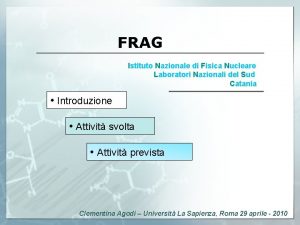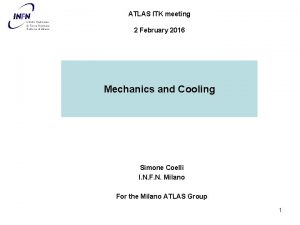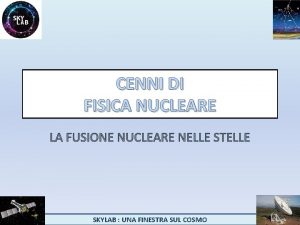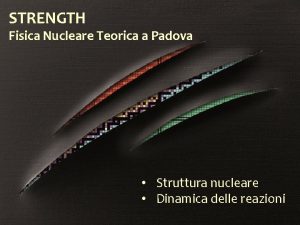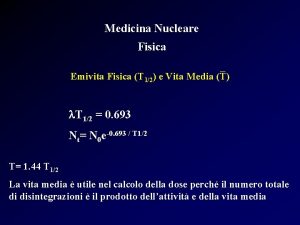Geoneutrinos Livia Ludhova Istituto Nazionale di Fisica Nucleare































![9 Li-8 He background Isotope T 1/2 [ms] Decay mode BR [%] Qb [Me. 9 Li-8 He background Isotope T 1/2 [ms] Decay mode BR [%] Qb [Me.](https://slidetodoc.com/presentation_image_h2/5d67315a2c653144b030711d82ed450d/image-32.jpg)





















- Slides: 53

Geoneutrinos Livia Ludhova Istituto Nazionale di Fisica Nucleare Milano, Italy LPC + LMV Clermont Ferrand October 19 th, 2012 Clermont Ferrand, October 19 th, 2012 Livia Ludhova

Outline • The Earth (mostly for physicists) • Neutrinos and anti-neutrinos (mostly for geologists) • Geoneutrinos • Current experiments • Reactor antineutrinos and other backgrounds; • Geo-neutrino signal predictions • Latest geoneutrino experimental results • Future Clermont Ferrand, October 19 th, 2012 Livia Ludhova

Outline • The Earth (mostly for physicists) Clermont Ferrand, October 19 th, 2012 Livia Ludhova

Earth structure Clermont Ferrand, October 19 th, 2012 Livia Ludhova

Earth structure Inner Core - SOLID • about the size of the Moon; • Fe – Ni alloy; • solid (high pressure ~ 330 GPa); • temperature ~ 5700 K; Outer Core - LIQUID • 2260 km thick; • Fe. Ni alloy + 10% light elem. (S, O? ); • liquid; • temperature ~ 4100 – 5800 K; • geodynamo: motion of conductive liquid within the Sun’s magnetic field; D’’ layer: mantle –core transition • ~200 km thick; • seismic discontinuity; • unclear origin; Clermont Ferrand, October 19 th, 2012 Livia Ludhova

Earth structure Lower mantle (mesosphere) • rocks: high Mg/Fe, < Si + Al; • T: 600 – 3700 K; • high pressure: solid, but viscose; • “plastic” on long time scales: CONVECTION Transition zone (400 -650 km) seismic discontinuity; • mineral recrystallisation; • : role of the latent heat? ; • partial melting: the source of midocean ridges basalts; Clermont Ferrand, October 19 th, 2012 Livia Ludhova

Earth structure Upper mantle • composition: rock type peridotite • includes highly viscose astenosphere on which are floating litospheric tectonic plates (lithosphere = more rigid upper mantle + crust); Crust: the uppermost part • OCEANIC CRUST: • created at mid-ocean ridges; • ~ 10 km thick; • CONTINENTAL CRUST: • the most differentiated; • 30 – 70 km thick; • igneous, metamorphic, and sedimentary rocks; • obduction and orogenesis; Clermont Ferrand, October 19 th, 2012 Livia Ludhova

Seismology P – primary, longitudinal waves S – secondary, transverse/shear waves Clermont Ferrand, October 19 th, 2012 Discontinuities in the waves propagation and the density profile but no info about the chemical composition of the Earth Livia Ludhova

Geochemistry 1) Direct rock samples Mantle-peridotite xenoliths xenolith * surface and bore-holes (max. 12 km); * mantle rocks brought up by tectonics and vulcanism; BUT: POSSIBLE ALTERATION DURING THE TRANSPORT 2) Geochemical models: composition of direct rock samples + C 1 carbonaceous chondrites meteorites + Sun’s photosphere; Bulk Silicate Earth (BSE) models (several!): medium composition of the “re-mixed” crust + mantle, i. e. , primordial mantle before the crust differentiation and after the Fe-Ni core separation; Clermont Ferrand, October 19 th, 2012 Livia Ludhova

Surface heat flux Bore-hole measurements • Conductive heat flow from bore-hole temperature gradient; • Total surface heat flux: 31 + 1 TW (Hofmeister&Criss 2005) 46 + 3 TW (Jaupart et all 2007) 47 + 2 TW (Davis&Davies 2010) (same data, different analysis) SYSTEMATIC ERRORS Different assumptions concerning the role of fluids in the zones of mid ocean ridges. Global Heat Flow Data (Pollack et al. ) Clermont Ferrand, October 19 th, 2012 Livia Ludhova

Sources of the Earth heat • Total heat flow (“measured”): 31+1 or 46+3 or 47+2 TW • Radiogenic heat = from decays of radioactive elements A) C 1 carbonaceous chondrites : 17 -21 TW from which ~9 TW from the crust and 0 from the core (the rest is in the mantle); B) Enstatic-chondrites models: (Javoy 2010): 11 TW!!! • Other heat sources (possible deficit up to 47 -11 = 36 TW!) – Residual heat: gravitational contraction and extraterrestrial impacts in the past; – 40 K in the core; – nuclear reactor; (BOREXINO rejects a power > 3 TW at 95% C. L. ) – mantle differentiation and recrystallisation; IMPORTANT MARGINS FOR ALL DIFFERENT MODELS OF THE EARTH STRUCTUE • Clermont Ferrand, October 19 th, 2012 Livia Ludhova

Outline • Neutrinos and anti-neutrinos (mostly for geologists) Clermont Ferrand, October 19 th, 2012 Livia Ludhova

LEPTONS particles - antiparticles lepton number +1 emt- ne nm nt lepton number -1 3 flavors ne produced in the nuclear reactions in the Sun; Total flux ~1010 cm-2 s-1 Detected via elastic scattering on e: ne + e - Clermont Ferrand, October 19 th, 2012 e+ m+ t+ ne nm nt ne produced in the nuclear powerplants (< 10 Me. V) and from the Earth radioactivity (geoneutrinos) (< 3 Me. V) Total geoneutrino flux ~106 cm-2 s-1 Livia Ludhova

Neutrino oscillations Each (anti-) neutrino flavour, electron, muon, tau is a superposition of 3 mass eigenstates, 1, 2, and 3, in different and characteristics proportions. An (anti-)neutrino of a given energy(momentum) represents a periodically evolving mixture of mass eigenstates, thus a probability to observe a certain flavor does oscillate during its passage. The probability to detect electron antineutrino (from nuclear power plant or geoneutrino) oscillates: q 12, q 13, Dm 122 … physical constants (oscillation parameters) sin 2 q 12 = 0. 306 + 0. 017; sin 2 q 13 = 0. 024 + 0. 004; dm 2 = (7. 6 + 0. 2) x 10 -5 e. V 2 L… source – detection distance E …. antineutrino energy in Me. V Clermont Ferrand, October 19 th, 2012 Livia Ludhova

Geoneutrinos No Oscillation Oscillated 3 Me. V antineutrino. . Oscillation length of ~100 km for geoneutrinos we can use average survival probability of 0. 551 + 0. 015 (Fiorentini et al 2012), but for reactor antineutrinos not! Reactor antineutrinos at LNGS No Oscillation E_antinu = 3 Me. V Oscillated Clermont Ferrand, October 19 th, 2012 Livia Ludhova

Outline • Geoneutrinos Clermont Ferrand, October 19 th, 2012 Livia Ludhova

Geoneutrinos: antineutrinos from the Earth • Electron antineutrinos from the decays of long lived radioactive isotopes naturally present in the Earth; • 238 U and 232 Th chains and 40 K (T 1/2 = (4. 47, 14. 0, 1. 28) x 109 years, resp. ): 206 Pb + 8 a + 8 e- + 6 anti-neutrinos + 51. 7 Me. V 232 Th 208 Pb + 6 a + 4 e- + 4 anti-neutrinos + 42. 8 Me. V 40 K 40 Ca + e- + 1 anti-neutrino + 1. 32 Me. V 238 U Earth shines in antineutrinos: flux ~ 106 cm-2 s-1 leaving freely and instantaneously the Earth interior (to compare: solar neutrino flux ~ 1010 cm-2 s-1) the only direct probe of the deep Earth released heat and anti-neutrinos flux in a well fixed ratio! measure geoneutrino flux = (in principle) = get radiogenic heat in practice (as always) more complicated…. . Clermont Ferrand, October 19 th, 2012 Livia Ludhova

Geoneutrinos: why to study them • Possible answers to the questions (most of them still far future though…) : – What is the radiogenic contribution to the terrestrial heat? ? – Are there any other heat sources or not? – What is the distribution of the long-lived radioactive elements within the Earth? • how much of them is in the crust and in the mantle; • Is their distribution in the mantle homogeneous or not; • are they present in the core; • is there a geo-reactor (Herndon 2001) ; – Are the BSE models compatible with geoneutrino data? – Discrimination among different BSE models; – What is the bulk Th/U ratio; All these info would give significant margins to many geochemical and geophysical models and insights into the models of the Earth’s formation. Clermont Ferrand, October 19 th, 2012 Livia Ludhova

Where is concentrated U, Th, and K ? • The main long-lived radioactive elements: 238 U, 232 Th, and 40 K U, Th, K are refractory lithophile elements (RLE) – Volatile /Refractory: Low/High condensation temperature – Lithophile – like to be with silicates: during partial melting they tend to stay in the liquid part. The residuum is depleted. Accumulated in the continental crust. Less in the oceanic crust. Mantle even smaller concentrations. Nothing in core. concentration for 238 U (Mantovani et al. 2004) upper continental crust: middle continental crust: lower continental crust: oceanic crust: upper mantle: core 2. 5 ppm 1. 6 ppm 0. 63 ppm 0. 1 ppm 6. 5 ppb NOTHING Clermont Ferrand, October 19 th, 2012 Livia Ludhova

Geoneutrinos energy spectra (theoretical calculations) 1. 8 Me. V = threshold for inverse b-decay reaction Geoneutrinos energy range Tgeo-n = 1. 8 - 3. 3 Me. V Evisible ~ 1 – 2. 5 Me. V Clermont Ferrand, October 19 th, 2012 Livia Ludhova

Detecting geo-n: inverse b-decay Energy threshold of Tgeo-n = 1. 8 Me. V g (0. 511 Me. V) i. e. Evisible ~ 1 Me. V ne p PROMPT SIGNAL e+ Evisible = Te + 2*0. 511 Me. V = = Tgeo-n – 0. 78 Me. V g (0. 511 Me. V) p Low reaction s large volume detectors Liquid scintillators High radio-purity & underground labs to shield from cosmic rays n n neutron thermalization up to cca. 1 m Clermont Ferrand, October 19 th, 2012 DELAYED SIGNAL mean n-capture time on p 256 ms g (2. 2 Me. V) Livia Ludhova

Outline • Current experiments Clermont Ferrand, October 19 th, 2012 Livia Ludhova

• only 2 running experiments measured geoneutrinos; • liquid scintilllator detectors; • (Anti-)neutrinos have low interaction rates, therefore: • Large volume detectors needed; • High radiopurity of construction materials; • Underground labs to shield cosmic radiations; Kam. Land in Kamioka, Japan Borexino in Gran Sasso, Italy Border bewteen OCEANIC AND CONTINENTAL CRUST • originally build to measure reactor antineutrinos; • 1000 tons; • S(reactors)/S(geo) ~ 6. 7 (2010) • 2700 meters water equivalent shielding; • originally build to measure neutrinos from the Sun – extreme radiopurity needed and achieved; • 280 tons; • S(reactors)/S(geo) ~ 0. 3 !!! (2010) • DAQ started in 2007; • 3600 m. w. e. shielding; Clermont Ferrand, October 19 th, 2012 Livia Ludhova

Kam. Land Clermont Ferrand, October 19 th, 2012 Borexino Livia Ludhova

Experimental principle basics antineutrino + proton positron + neutron E (prompt) = E(antineutrino) – 0. 78 MEV Edelayed = 2. 2 Me. V gamma D time DR § Charged particles produce scintillation light; § Gamma rays from the positron annihilation and from the neutron capture are neutral particles but in the scintillator they interact mostly via Compton scattering producing electrons = charged particles; § Scintillation light is detected by an array of phototubes (PMTs) converting optical signal to electrical signal; § Number of hit PMTs = function (energy deposit) -> Eprompt, Edelayed § Hit PMTs time pattern = position reconstruction of the event -> D R of events § Each trigger has its GPS time -> D time of events Clermont Ferrand, October 19 th, 2012 Livia Ludhova

Outline • Reactor antineutrinos and other backgrounds; We have golden candidates found as time and spatial coincidences. They can be due to: • Geo-neutrinos; • Reactor antineutrinos; • Other backgrounds; We need to estimate different contributions and then extract the number of measured geo-neutrinos by fitting the Eprompt spectrum; Mostly illustrated on Borexino background analysis; Qualitatively Kam. LAND has the same background type; Clermont Ferrand, October 19 th, 2012 Livia Ludhova

Reactor antineutrinos Survival probability vs distance ∆m 212 = 7. 65 · 10− 5 e. V 2 sin 2θ 12=0. 304 CHOOZ Kam. LAND Proposal BOREXINO Lmean ~ 1000 km 194 reactors 245 world non European reactors Clermont Ferrand, October 19 th, 2012 Livia Ludhova

Calculation of reactor anti-n signal From the literature: Ei : energy release per fission of isotope i (Huber-Schwetz 2004); Φi: antineutrino flux per fission of isotope i (polynomial parametrization, Mueller et al. 2011, Huber-Schwetz 2004); Pee: oscillation survival probability; Calculated: Tm: live time during the month m; Lr: reactor r – detector distance; 235 U 239 Pu 238 U 241 Pu Data from nuclear agencies: Prm: thermal power of reactor r in month m (IAEA , EDF, and UN data base); fri: power fraction of isotope i in reactor r; Clermont Ferrand, October 19 th, 2012 Livia Ludhova

Expected signal and its error in Borexino Fn (En>1. 8 Me. V)= (9. 0 +0. 5)104 cm-2 s-1 Source of error s~10 -44 cm 2 Nprotons = 6 x 1030 in 100 tons Error (%) Oscillations: Δm 2 Oscillations: ϑ 12 ± 0. 02% ± 2. 6% Energy per fission of isotope i: Ei ± 0. 6% Flux shape: Φi(Eν) Cross section: σ(E) Thermal power: Prm Long lived isotopes in spent fuel ± 2. 5% ± 0. 4% ± 2% ± 1% Fuel composition: fri ± 3. 2% Reactor – Borexino distance Lr ± 0. 4% TOTAL (5. 7+0. 3) events/yr/100 t ± 5. 38% Clermont Ferrand, October 19 th, 2012 Energy spectrum of prompt events 235 U 239 Pu 238 U 241 Pu Sum with oscil. Sum NO oscil. Prompt energy (Me. V) Livia Ludhova

Background sources μ μ Reactions which can mimick the golden coincidence: 1) Cosmogenic-muon induced: • 9 Li and 8 He decaying b-n; • neutrons of high energies; neutrons scatters proton = prompt; neutron is captured = delayed; • Non-identified muons; μ μ Limestone rock n n n, 9 Li, 8 He n 2) Accidental coincidences; 3) Due to the internal radioactivity: (a, n) and (g, n) reactions Clermont Ferrand, October 19 th, 2012 Livia Ludhova

Muons crossing the OD • To remove fast neutrons originated in the Water Tank we apply a 2 ms (~ 8 neutron capture livetimes) veto after each detected muon by the OD; μ Limestone rock • In correlation with OD tagged muons we have observed 2 fake anti-n candidates; • The inefficiency of OD muon veto is 5× 10 -3; n • For this background we can set an upper limit of < 0. 01 events/(100 ton-year) at 90% C. L. Clermont Ferrand, October 19 th, 2012 Livia Ludhova
![9 Li8 He background Isotope T 12 ms Decay mode BR Qb Me 9 Li-8 He background Isotope T 1/2 [ms] Decay mode BR [%] Qb [Me.](https://slidetodoc.com/presentation_image_h2/5d67315a2c653144b030711d82ed450d/image-32.jpg)
9 Li-8 He background Isotope T 1/2 [ms] Decay mode BR [%] Qb [Me. V] 8 He 119. 0 b+n 16 5. 3, 7. 4 9 Li 178. 3 b+n 51 1. 8, 5. 7, 8. 6, 10. 8, 11. 2 • induced by cosmogenic muons; • we apply 2 s dead time (several livetimes) after each internal m; • from this cut is implied 10% reduction of live time (muon flux ~ 4300/day); • as a background for geon we calculate the exponential tail at time > 2 s; Clermont Ferrand, October 19 th, 2012 51 candidates found within 2 s after muons Rate of coincodences: 15. 4 events/100 tons/year Bgr for geonu: < 0. 03± 0. 02 ev/100 tons/year Livia Ludhova

Accidental coincidences • Same cuts, just dt instead of 20 -1280 ms is 2 -20 s in order to maximise the statistics and so minimise the error; Visible energy of the prompt event 0. 080± 0. 001 events/(100 ton-year) Clermont Ferrand, October 19 th, 2012 Livia Ludhova

13 C(a, n)16 O 1) Isotopic abundance of 13 C: 1. 1% 2) 210 Po contamination: APo~ 12 cpd/ton Clermont Ferrand, October 19 th, 2012 Livia Ludhova

MC for 13 C (a, n)16 O Probability for 210 Po nucleus to give (a, n) in pure In PC it corresponds to (5. 0+0. 8)10 -8 13 C (6. 1+0. 3) 10 -6 (Mc Kee 2008). recoiled proton 12 C* Selection cut > 410 p. e. from neutron 16 O* (0. 014+0. 001) events/(100 tons yr) Clermont Ferrand, October 19 th, 2012 Livia Ludhova

Summary of backgrounds Background source Cosmogenic 9 Li and 8 He events/(100 ton-year) 0. 03 ± 0. 02 Fast neutrons from μ in Water Tank (measured) < 0. 01 Fast neutrons from μ in rock (MC) < 0. 04 Non-identified muons 0. 011 ± 0. 001 Accidental coincidences 0. 080 ± 0. 001 Time correlated background < 0. 026 (γ, n) reactions < 0. 003 Spontaneous fission in PMTs 0. 003 ± 0. 0003 (α, n) reactions in the scintillator [210 Po] 0. 014 ± 0. 001 (α, n) reactions in the buffer [210 Po] TOTAL We expect ~2. 5 geo-n/(100 ton-year) Clermont Ferrand, October 19 th, 2012 < 0. 061 0. 14 ± 0. 02 (assuming BSE) Livia Ludhova

Results: 21 candidates selected in Borexino in 483 live days (252. 6 ton-year after all cuts) Radial distribution Events vs time Realative time distance t. Best-fit = 279 ms compatible with neutron capture time Clermont Ferrand, October 19 th, 2012 Livia Ludhova

Outline • Geoneutrino signal prediction Clermont Ferrand, October 19 th, 2012 Livia Ludhova

Bulk Silicate Earth (BSE) Models G. Fiorentini et al. : Mantle Geoneutrinos in Kamland Borexino, ar. Xive 1204. 1923 M(Th) / M (U) 4. 0 3. 8 3. 9 C 1 chondrites 3. 9 3. 7 3. 4 enstatites ratios of element abundances more stable in different models with respect to their absolute abundances. K/U ~ 13 000 Current mantle = primitive mantle (BSE) – current crust Current crust = LOC (Local Crust) + ROC (Rest Of the Crust) Clermont Ferrand, October 19 th, 2012 Livia Ludhova

Medium Crustal Composition and ROC G. Fiorentini et al. : Mantle Geoneutrinos in Kamland Borexino, ar. Xive 1204. 1923 Geometry and volumes: 1 Terrestrial Neutrino Unit (TNU) = 1 event / year / 1032 protons (~ 1 kton scitnillator) Clermont Ferrand, October 19 th, 2012 Livia Ludhova

Local Crust Contribution • contribution from the surrounding crust (few hundred km) is an important fraction of the measured geoneutrino signal; • collaboration among physicists and geologists is a must; • detailed 3 D models of local geology + geochemical analysis of the main lithotypes needed; Kam. LAND: igneous rocks rich in U and Th: total ~18 TNU G. Fiorentini et al. : Mantle Geoneutrinos in Kamland Borexino, ar. Xive 1204. 1923 Borexino: surrounded by dolomites, very low U + Th content: total ~10 TNU Clermont Ferrand, October 19 th, 2012 Livia Ludhova

Current Mantle Contribution • = BSE (primitive mantle) – crust ; • mantle is assumed to be spherically symmetric; • how is the remaining U and Th distributed in the current mantle? • “low signal” scenario = homogeneous; • “high signal” scenario = concentrated at the core-mantle boundary; (U and Th concentration in the upper mantle is not possible due to the depeletion In these elements due to the crust differentiation) G. Fiorentini et al. : Mantle Geoneutrinos in Kamland Borexino, ar. Xive 1204. 1923 Clermont Ferrand, October 19 th, 2012 Livia Ludhova

Outline • Latest geoneutrino experimental results Kam. Land Borexino high exposure: 99. 997 CL observation in 2011 (Gando et al, Nature Geoscience 1205) small exposure but low background level: observation at 99. 997 CL in 2010 (Bellini et al, PLB 687): 106 +29 – 28 geonu events detected; (March 2002 – April 2009) exposure 3. 49 x 1032 target-proton year 9. 9 +4. 1 – 3. 4 geonu events detected; (December 2007 – December 2009) Exposure 0. 15 x 1032 target-proton year • active geo-reactor in the Earth core of power > 3 TW excluded at 95% CL; Clermont Ferrand, October 19 th, 2012 Livia Ludhova

Kam. Land Borexino ~1 Me. V th, (2011). A. Gando et al. , Ferrand, Nature Geoscience 1205 Clermont October 19 2012 ~3 Me. V ~7 Me. V G. Bellini et al. , PLB 687 (2010) 299 -304. Livia Ludhova

Combined analysis A. Gando et al. , Nature Geoscience 1205 (2011). • indication of mantle contribution ; • Fully radiogenic model excluded at 97% CL (CAREFULL WITH ASSUMPTIONS!) (combined Kam. Land + Borexino data: uranium-238 and thorium-232: 20. 0+8. 8 -8. 6 TW, from geology: potassium-40 contributes 4 TW ) Clermont Ferrand, October 19 th, 2012 Livia Ludhova

Combined analysis G. Fiorentini et al. : Mantle Geoneutrinos in Kamland Borexino, ar. Xive 1204. 1923 Clermont Ferrand, October 19 th, 2012 No mantle Geoneutrinos Disfavoured at > 2 sigma Livia Ludhova

Outline • Future Clermont Ferrand, October 19 th, 2012 Livia Ludhova

Running and planned experiments having geoneutrinos among their aims Mantovani 2004 Clermont Ferrand, October 19 th, 2012 Livia Ludhova

SNO+ at Sudbury, Canada SHOULD BE COMING SOON! After SNO: D 2 O replaced by 1000 tons of liquid scintillator M. J. Chen, Earth Moon Planets 99, 221 (2006) Placed on an old continental crust: 80% of the signal from the crust (Fiorentini et al. , 2005) BSE: 28 -38 events/per year Mantovani et al. , TAUP 2007 Clermont Ferrand, October 19 th, 2012 Livia Ludhova

Hanohano at Hawaii Antineutrino Observatory (HANO = "magnificent” in Hawaiian Project for a 10 kton liquid scintillator detector, movable and placed on a deep ocean floor J. G. Learned et al. , XII International Workshop on Neutrino Telescopes, Venice, 2007. Since Hawai placed on the U-Th depleted oceanic crust 70% of the signal from the mantle! Would lead to very interesting results! (Fiorentini et al. ) BSE: 60 -100 events/per year Mantovani , TAUP 2007 Clermont Ferrand, October 19 th, 2012 Livia Ludhova

LENA at Pyhasalmi, Finland Project for a 50 kton underground liquid scintillator detector (Hochmuth et al 2007) 80% of the signal from the continental crust (Fiorentini et al. ) BSE: 800 -1200 events/per year MC data 1 year stat Within the first few years, the total geoneutrino flux could be measuered at few % precision Reactor + geo Strong potential in determining the U/Th ratio of the measured geonu flux (Wurm et al 2011) Clermont Ferrand, October 19 th, 2012 Livia Ludhova

Summary • The new interdisciplinary field is born; • Collaboration among geologists and physicists is a must; • The current experimental results confirm that geo-neutrinos can be successfully detected; • Signal prediction and data interpretation: local geology around the experimental site must be studied; • The combined results from different experimental sites have stronger impact – first geologically significant results start to appear; • New measurements and the new generation experiments are needed for geologically highly significant results; Clermont Ferrand, October 19 th, 2012 Livia Ludhova

THANK YOU!!! Clermont Ferrand, October 19 th, 2012 Livia Ludhova
 Livia ludhova
Livia ludhova Livia ludhova
Livia ludhova Itt livia bottardi
Itt livia bottardi Unità di misura in fisica nucleare
Unità di misura in fisica nucleare Istituto nazionale di urbanistica
Istituto nazionale di urbanistica Istituto gemmologico nazionale
Istituto gemmologico nazionale Caso livia
Caso livia Livia petti
Livia petti Livia grgić
Livia grgić Livia danieli
Livia danieli Livia d
Livia d Rome 480 bc
Rome 480 bc Macbeth connections
Macbeth connections Livia stone
Livia stone Livia kernova
Livia kernova Fusione nucleare
Fusione nucleare Cataratta cortico nucleare
Cataratta cortico nucleare Fissione nucleare
Fissione nucleare Schema centrale nucleare
Schema centrale nucleare Interazione nucleare debole
Interazione nucleare debole Testo espositivo esempi
Testo espositivo esempi Detector de radiatii nucleare
Detector de radiatii nucleare Funzionamento centrale nucleare
Funzionamento centrale nucleare Fusione nucleare
Fusione nucleare Frasi nucleari esempi
Frasi nucleari esempi Luranio
Luranio Interazione nucleare debole
Interazione nucleare debole Forza
Forza Marcato pleomorfismo nucleare
Marcato pleomorfismo nucleare Fusione nucleare schema
Fusione nucleare schema Energia nucleare schema
Energia nucleare schema Energia nucleare riassunto
Energia nucleare riassunto Interazione nucleare debole
Interazione nucleare debole Sequenze segnale
Sequenze segnale Fissione nucleare
Fissione nucleare Spedali civili brescia medicina nucleare
Spedali civili brescia medicina nucleare Interazione nucleare debole
Interazione nucleare debole A liuba che parte zanichelli
A liuba che parte zanichelli Registro nazionale società sportive dilettantistiche
Registro nazionale società sportive dilettantistiche Festa nazionale inghilterra
Festa nazionale inghilterra Borsa nazionale del lavoro
Borsa nazionale del lavoro Infn lab nazionale di legnaro, legnaro
Infn lab nazionale di legnaro, legnaro Classificazione cnd dispositivi medici
Classificazione cnd dispositivi medici Sport in germania
Sport in germania Centro nazionale trapianti
Centro nazionale trapianti Direzione nazionale antimafia e antiterrorismo
Direzione nazionale antimafia e antiterrorismo Rete accelerometrica nazionale
Rete accelerometrica nazionale Inno di mameli da stampare
Inno di mameli da stampare Consolidato nazionale e mondiale differenza
Consolidato nazionale e mondiale differenza Tesori da scoprire fidapa
Tesori da scoprire fidapa Galleria nazionale delle marche
Galleria nazionale delle marche Assdi nazionale
Assdi nazionale Centro nazionale trapianti
Centro nazionale trapianti Rete accelerometrica nazionale
Rete accelerometrica nazionale
